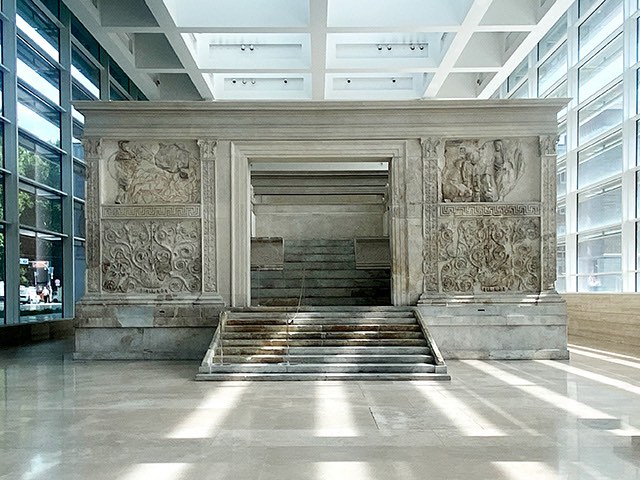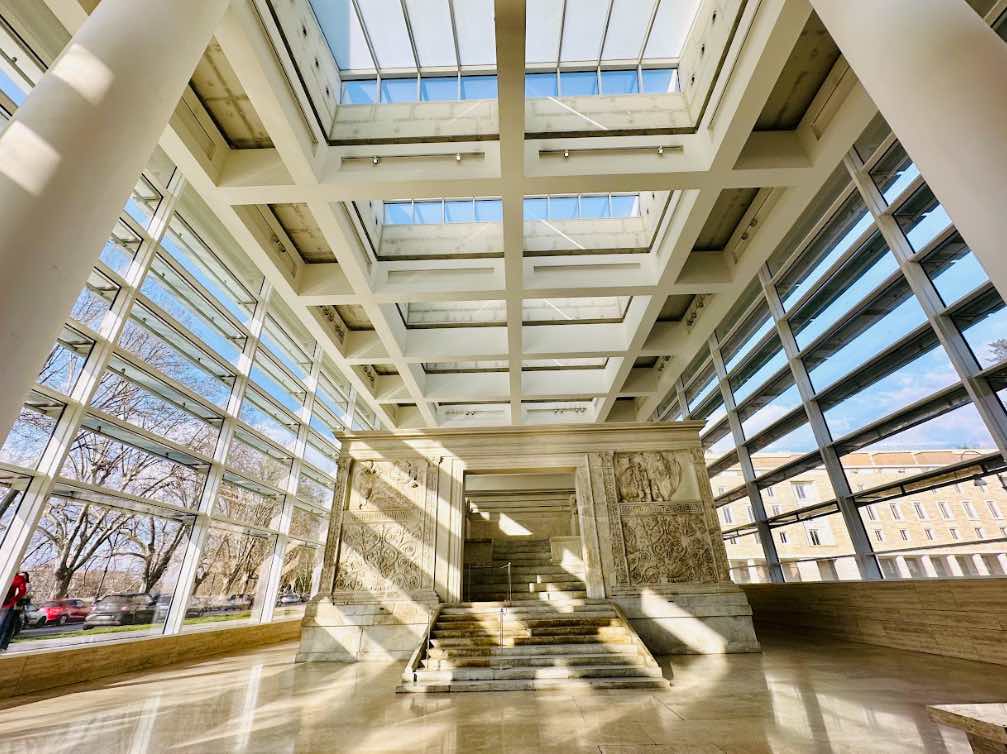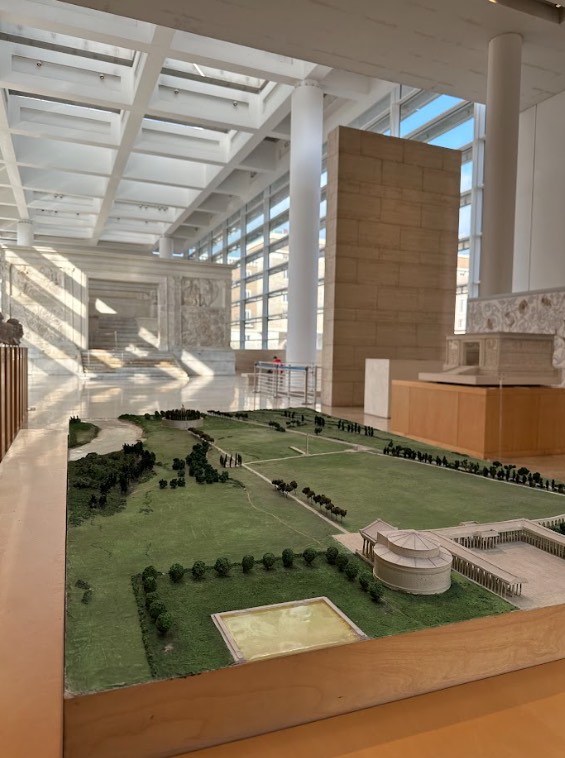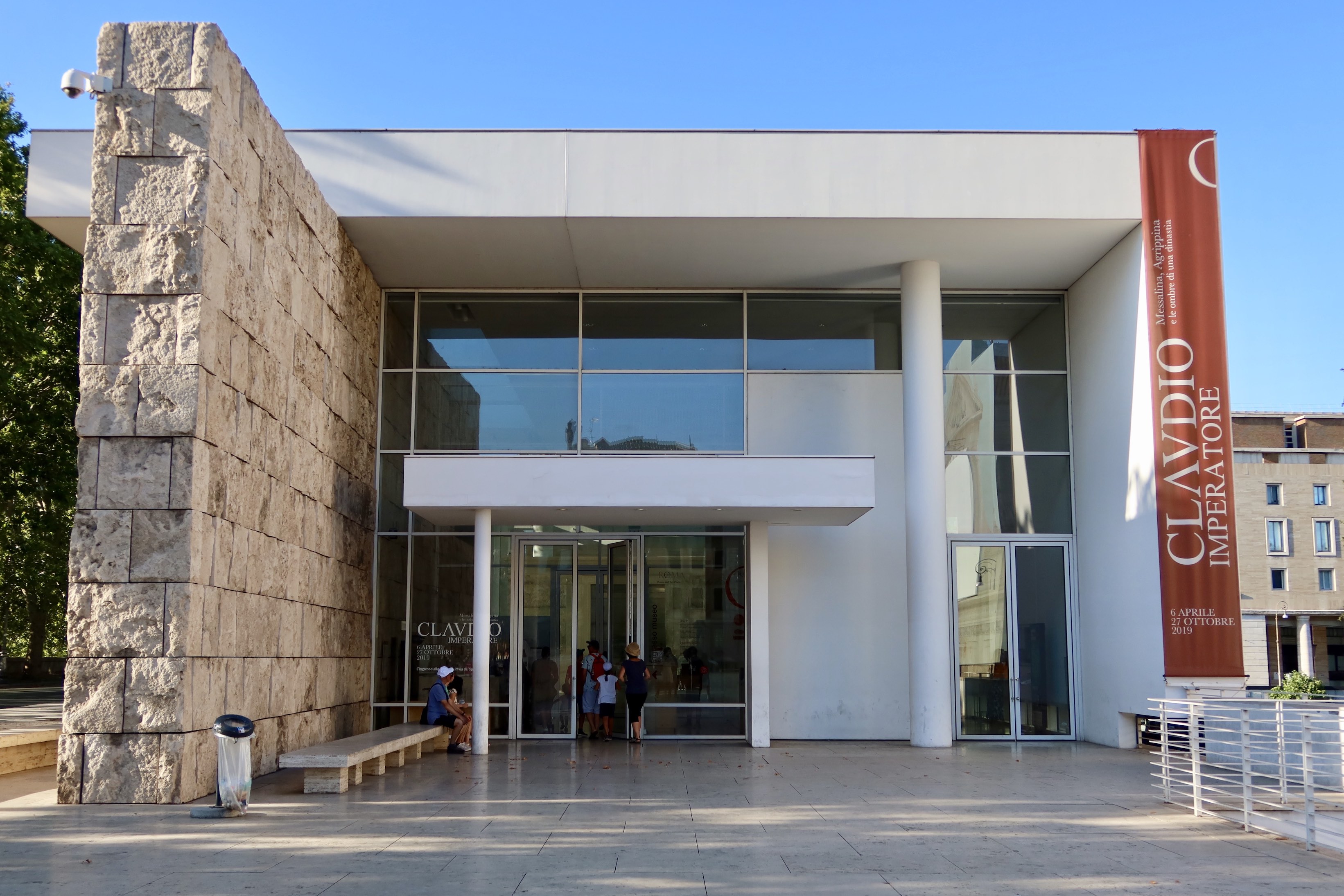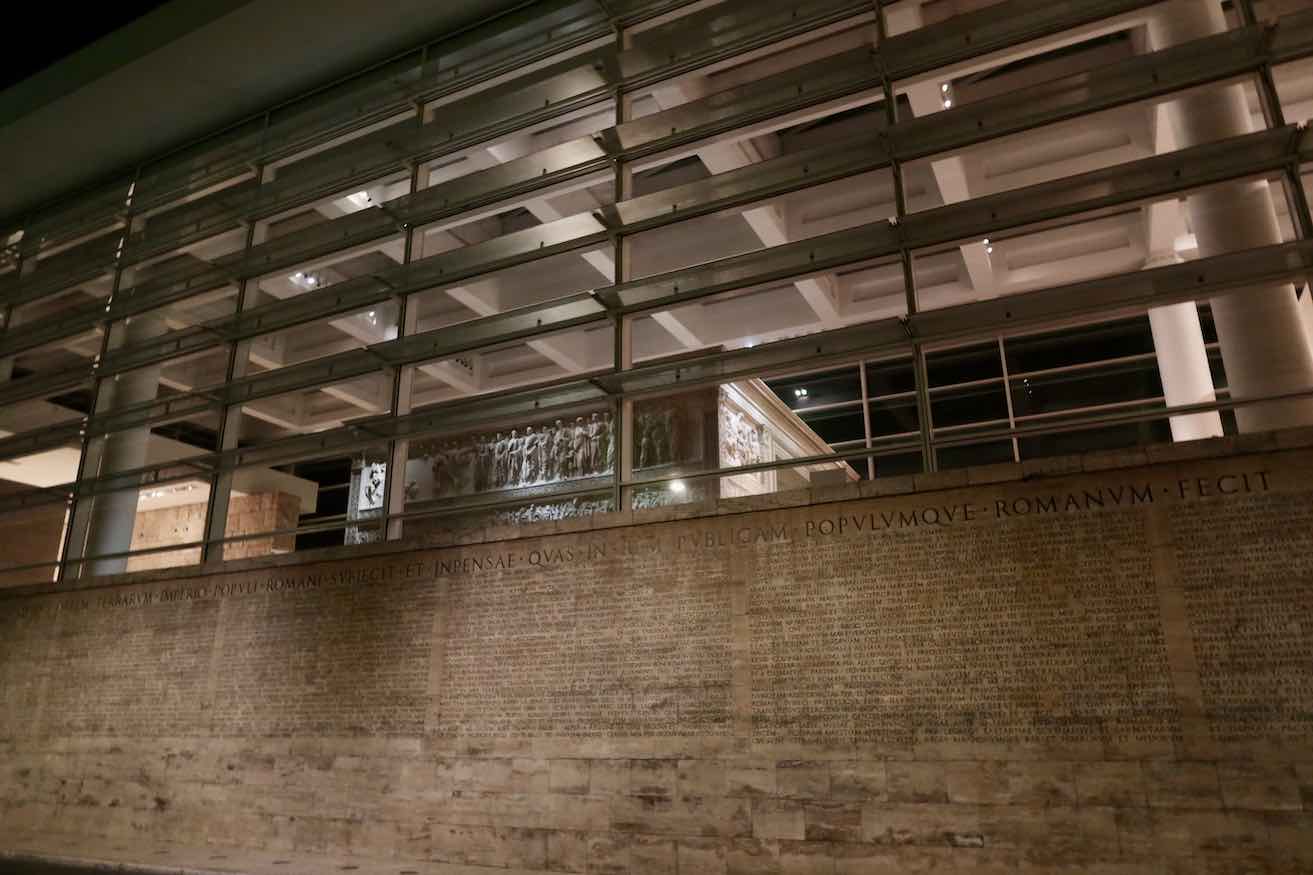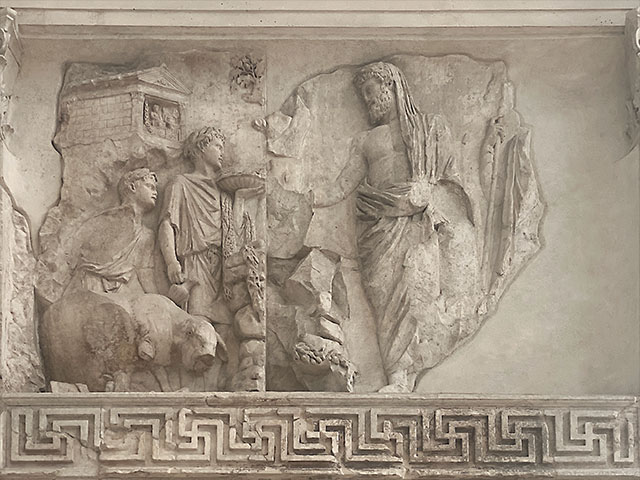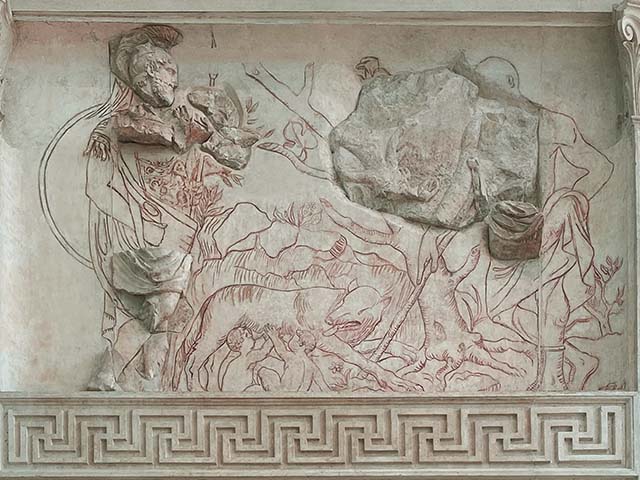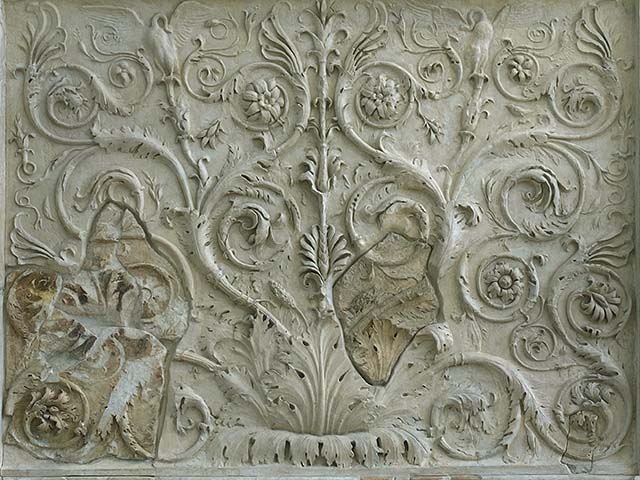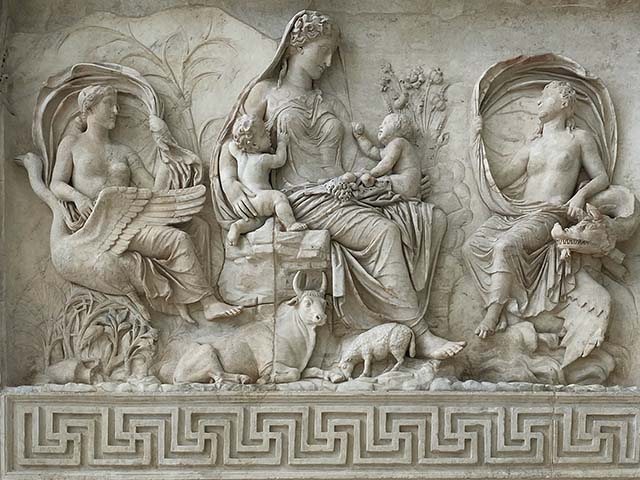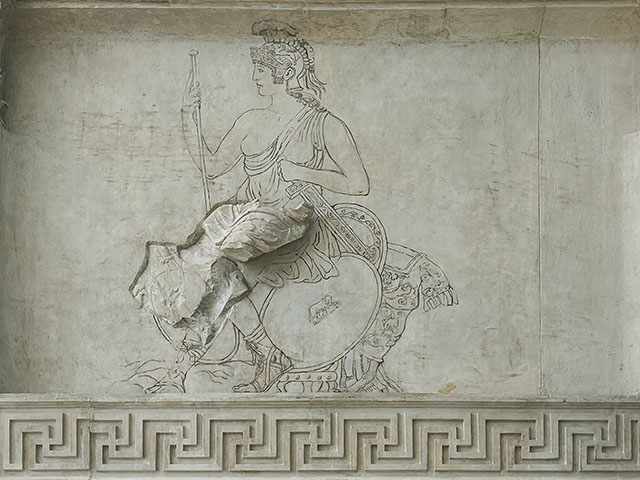- Sign up & get a FREE ebook Subscribe NOW!
- Romewise Home Page
- What to Do in Rome
- Ara Pacis
Ara Pacis Augustae
You may have seen reference to the Ara Pacis when planning your Rome trip, but what exactly is it?
Keep reading to discover everything you need to know about one of Rome's most unique monuments; the Ara Pacis Augustae.
Rome's Ara Pacis - Everything you need to know
Incredibly, the Ara Pacis dates back to the time of the first Roman emperor, Augustus.
This means that when you're standing in front of the reconstructed altar, you are looking at something that was a focal point of ancient Rome, which is pretty amazing!
Visiting the altar of Augustan peace tends to be quite low on most visitors list of must-sees, but I'm here to tell you that it is absolutely worth taking the time to visit.
On this page we'll go over:
- What is the Rome Ara Pacis Augustae?
- Where is the Ara Pacis?
- Why visit the Ara Pacis Augustae?
- The history of the Ara Pacis Augustae
- The construction of the Ara Pacis Augustae
- The Ara Pacis Museum
- All about the Res Gestae Divi Augusti
- What do the reliefs and sculptures on the Ara Pacis depict?
- Where to eat and drink near the Ara Pacis
What is the Ara Pacis Augustae?
The Ara Pacis Augustae, or Altar of Augustan Peace in Rome, is one of the most important and well-preserved examples of Roman art and architecture still surviving today.
The altar was built to celebrate the peace and prosperity brought to the Roman Empire during the reign of Emperor Augustus (Pax Romana or Pax Augusta) and is now a must-see when visiting Rome.
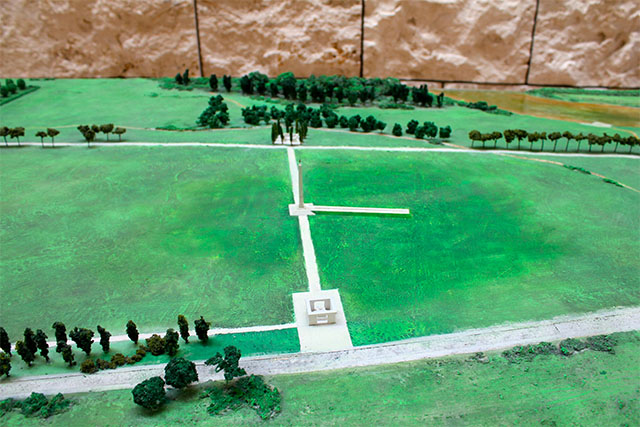 When you first enter the Ara Pacis museum you'll find a beautiful model showing how the altar would have looked in the local landscape when it was first constructed.
When you first enter the Ara Pacis museum you'll find a beautiful model showing how the altar would have looked in the local landscape when it was first constructed.Where is the Ara Pacis Augustae?
Today, the Rome Ara Pacis is located at Lungotevere in Augusta, 00186 in Rome, adjacent to the Tiber river and Piazza Augusto Imperatore where the reconstructed altar is housed in a dedicated museum.
However, the Altar of Augustan Peace was originally located at the juncture (of the modern streets) of Via in Lucina and Via del Giardino Theodoli.
Keep reading to find out why the location of this monument is now different compared to ancient times!
Why visit the Ara Pacis Augustae?
The Ara Pacis is one of the key Augustan monuments from the ancient city and a preeminent example of Roman sculpture.
It represents a period in ancient Roman history that shaped the future of the Roman empire, and by extension the western world.
The Ara Pacis Augustae is also relevant to Rome and Italy's modern history; its reconstruction and placement in its current location was sponsored by Benito Mussolini and his regime in the 1930s.
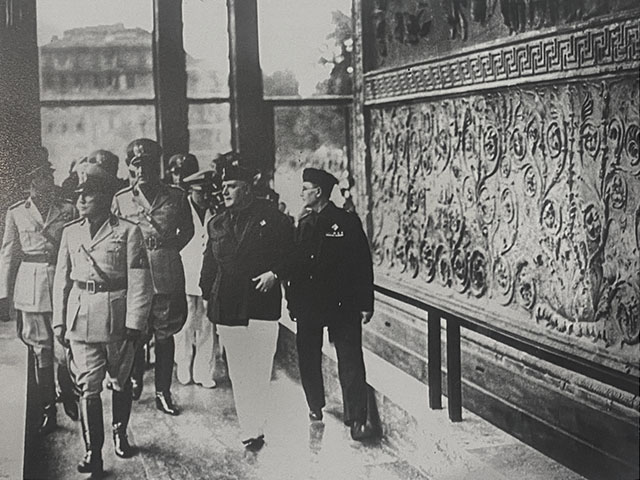 The accompanying museum tells the story of how the Ara Pacis was reconstructed in it's current position
The accompanying museum tells the story of how the Ara Pacis was reconstructed in it's current positionMussolini was attempting to capture some of ancient Rome's, and specifically, Augustus' past glory by associating himself with the Altar of Augustan Peace.
In my opinion no other monument in Rome encapsulates such a span of history.
Life of Emperor Augustus
Want to learn more about the life of Rome's first emperor, Octavian Augustus?
John Williams' book "Augustus" is a fictional recounting of Augustus' life from the moment he heard of his uncle Julius Caesar's assassination in 44 BCE.
The book tells the story through imagined epistles and it's a fantastic and easy way to absorb the history of this pivotal moment in Rome's history.
Disclosure: If you make a purchase through a link on this page, I may receive a small commission - at no extra cost to you. Thank you for supporting my site!
History of the Ara Pacis Augustae
Construction of the Altar of Augustan Peace began in 13 BCE and it was inaugurated in 9 BCE.
It was commissioned by the Roman Senate to honor Augustus' return from Hispania and Gaul (modern day Spain and Portugal, and France and Belgium respectively), where he had consolidated the control and influence of the Roman empire.
The altar was created to be an embodiment of the Pax Romana (Roman Peace), a period of relative stability and prosperity for ancient Rome.
After its completion the Rome Ara Pacis stood in the Campus Martius, an open space in the city used for public gatherings and military training.
During the Middle Ages, it was buried under sediment following floods of the river Tiber and gradually forgotten.
It was rediscovered in the 16th century and subsequently excavated in more recent times.
During the early 20th century the Ara Pacis Pavilion was constructed to house the reconstructed altar.
In order to protect the altar for future generations the Ara Pacis museum was built.
Designed by the American architect Richard Meier, the museum opened in 2006.
The modern structure features glass walls and a minimalist design that contrasts with the ancient marble altar, creating a unique juxtaposition of ancient and contemporary architecture.
Today, the Ara Pacis museum attracts visitors who come to admire the intricate ancient Roman relief sculpture and learn about its historical and artistic significance.
The Ara Pacis stands as a testament to the artistic achievements of ancient Rome and serves as a tangible symbol of the Augustan era and the Pax Romana.
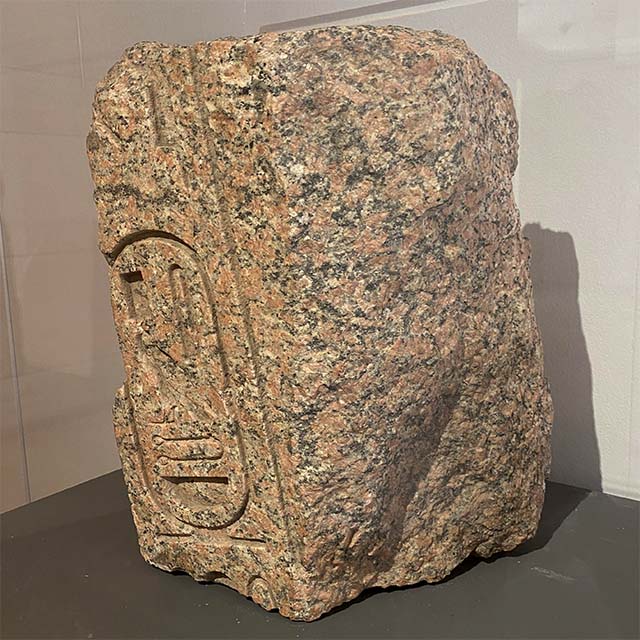 You'll often find special temporary exhibitions in the space under the Ara Pacis Rome - well worth taking the trip downstairs to see treasures like this fragment of the Montecitorio obelisk!
You'll often find special temporary exhibitions in the space under the Ara Pacis Rome - well worth taking the trip downstairs to see treasures like this fragment of the Montecitorio obelisk!About the construction of the Ara Pacis Augustae
The location chosen for the Ara Pacis Augustae was the Campus Martius, a public space in Rome traditionally associated with the military and government functions.
The altar itself is made of white Carrara marble and adorned with intricate reliefs.
The reliefs depicted various scenes and figures associated including members of the imperial family, figures from the Roman religion, and allegorical representations of Rome and its virtues.
The reliefs were carved by a team of skilled sculptors.
The level of detail and craftsmanship exhibited in the reliefs is some of the best surviving evidence of the artistic skill and technical expertise of the Roman artisans of the time.
The rectangular structure surrounding the altar, known as 'the precinct', was built to enclose and protect the Ara Pacis, the altar itself.
Today, the Ara Pacis Augustae stands as an important archaeological and invaluable example of early Roman imperial art.
It is housed in the Ara Pacis museum (more about this below!), where you can admire the monument in its reconstructed state with its beautifully preserved reliefs.
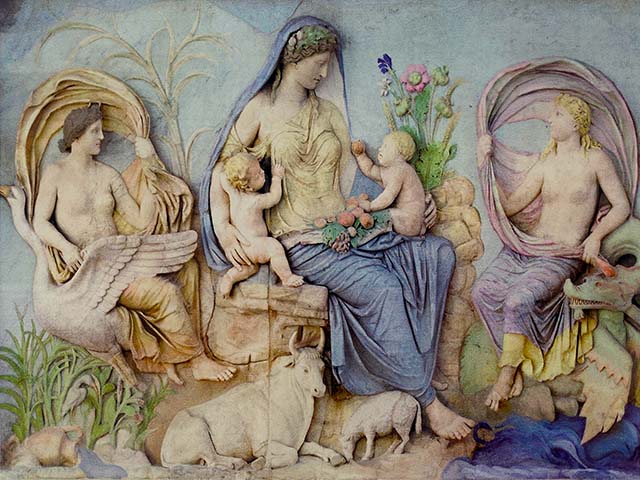 A theorised version of how one of the Ara Pacis' most famous reliefs may have looked originally - the entire monument would have been painted in vivid colors.
A theorised version of how one of the Ara Pacis' most famous reliefs may have looked originally - the entire monument would have been painted in vivid colors.The Ara Pacis Museum
Following a series of excavations and discoveries in the 19th and 20th century where the Ara Pacis emerged piece by piece, it was agreed that the monument should be reconstructed.
It was also agreed that a structure would be created to house the Ara Pacis, protecting it from the elements and in honor of its importance in the history of Rome.
The 'Ara Pacis Pavillion' was inaugurated on September 23 (Augustus' birthday) 1938 by Benito Mussolini at Lungotevere in Augusta.
The new (and current) location was chosen away from its original position for two reasons:
- The original location at the juncture of Via in Lucina and Via del Giardino Theodoli was, and still is, a densely developed area with historically significant palaces.
- Mussolini's regime believed that the Ara Pacis Augustae should take pride of place next to the newly-developed Piazza Augusto Imperatore and the Mausoleum of Augustus.
The Altar of Augustan Peace continues to reside at the same location, but now in a more modern building opened in 2006, designed by architect Richard Meier as a replacement for the ageing fascist-era pavilion.
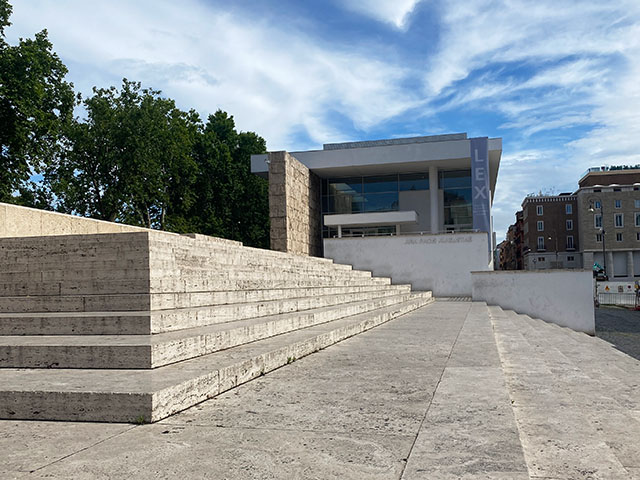 The new building is deliberately modern, in juxtaposition to the Ara Pacis Augustae, to highlight the beauty of the ancient monument inside.
The new building is deliberately modern, in juxtaposition to the Ara Pacis Augustae, to highlight the beauty of the ancient monument inside.About the Res Gestae Divi Augusti
Outside the Ara Pacis museum you will find a reconstruction of the Res Gestae Divi Augusti, which was created at the same time as the Ara Pacis Pavilion.
The Res Gestae Divi Augustus, meaning 'the achievements of the divine Augustus', was an account of Augustus' reign, written by himself.
In this ancient autobiography Augustus advertises his successes to the Roman populace.
Augustus pioneered the use of propaganda and the Res Gestae Divi Augusti was immortalised in monuments across the Roman empire where they reminded everyone of Augustus and the Augustan Peace.
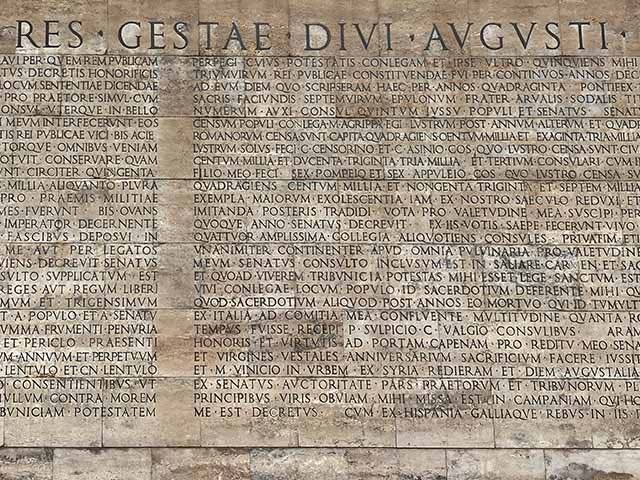 If you understand Latin you can read the 'the achievements of the divine Augustus' outside the Ara Pacis Museum, or find English translations online.
If you understand Latin you can read the 'the achievements of the divine Augustus' outside the Ara Pacis Museum, or find English translations online.Visiting the Ara Pacis Museum
The Ara Pacis museum is part of the 'Musei in Comune' organisation that manages most of Rome's most significant museums, including the Capitoline Museums and Palazzo Massimo alle Terme (Museo Nazionale).
For the latest ticket pricing information and visiting hours refer to the official website.
The museum routinely features special exhibitions in the space under the Ara Pacis precinct and altar.
Note that typically there is an extra charge to visit the museum when there is a special exhibit running.
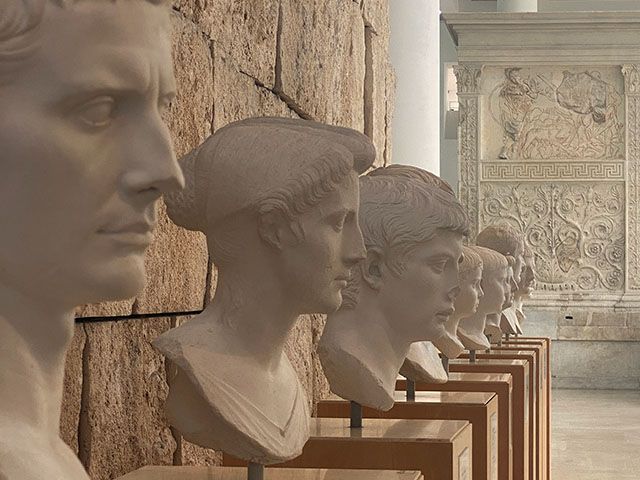 The Ara Pacis museums features a number of other artefacts and items, such as these replica busts of key ancient Romans from the Augustan era.
The Ara Pacis museums features a number of other artefacts and items, such as these replica busts of key ancient Romans from the Augustan era.You should allow between one and two hours to visit the Ara Pacis museum and any special exhibitions.
On site you will find a well-stocked gift and bookshop and bathrooms.
Note that there is no bar/cafe or restaurant on site, for recommendations on where to eat and drink nearby, keep reading!
The Ara Pacis museum is accessible to anyone with mobility challenges via ramps located outside the main entrance.
Once inside you will find the Ara Pacis Augustae itself on the ground level, just inside the museum entrance.
The bathrooms are on this same level, at the back of the museum.
Richard Meier deliberately designed his building to enable everyone to enjoy the beauty of the Ara Pacis.
So if you're pressed for time or traveling to Rome on a budget you can see the Ara Pacis for free from the outside.
Simply walk along the glass wall on the Lungotevere and peer in!
The perfect 3-day itinerary in Rome
Trying to figure out how to organize your visit to Rome? I've got the perfect 3-day itinerary for first-time visitors (or those who have not been here in a while.) It works for a 2.5 day visit as well.
In my 3-day itinerary, you'll see all the major must-see Rome attractions like the Vatican, Colosseum, Trevi Fountain, Pantheon, Piazza Navona, Spanish Steps, and much more.
And if you have more time, or want suggestions for extra/other things to do, you'll find that there too.
Visit my page with the best 3-day itinerary in Rome for first-timers.
What do the reliefs and sculptures on the Ara Pacis depict?
Let's examine what each part of this ancient Roman treasure represents:
The West Wall
This is the first side of the Altar of Augustan Peace that you see when entering the Ara Pacis museum.
Referring to the top right panel, you will see a scene that is generally considered to depict the famous Trojan Aeneas sacrificing a sow to the Penates, the household gods of the Trojans.
Aeneas is a key figure in the foundation of Rome, and Emperor Augustus claimed direct descendancy from him.
On the opposite, left side top, the few surviving fragments have been recognised as showing other key figures in Rome's history: Romulus and Remus, the famous twins credited with the city's founding.
The 'Panel of the Lupercal' likely depicted a traditional scene of the twins suckling at the she-wolf, with the god Mars (their creator) and their adopted father Faustulus.
Beneath both of these panels, and running around the entirety of the lower half of the precinct you will see the 'Great Vegetal Frieze'.
When looking at this consider originally that it would have been painted (as would have the whole monument) in vivid colors to mimic nature.
The frieze features a range of plants, all perfectly arranged in symmetry, as well as several animals and insects from the Roman world.
The North Wall
Moving clockwise as you face the west wall, you will find the north processional frieze stretching the length of the Altar of Augustan Peace.
This scene, along with the corresponding representation on the south side (more about this below) are believed to show one continuous procession.
This side begins with members of Augustus' family before transitioning to show priests from the Roman state religion and government officials.
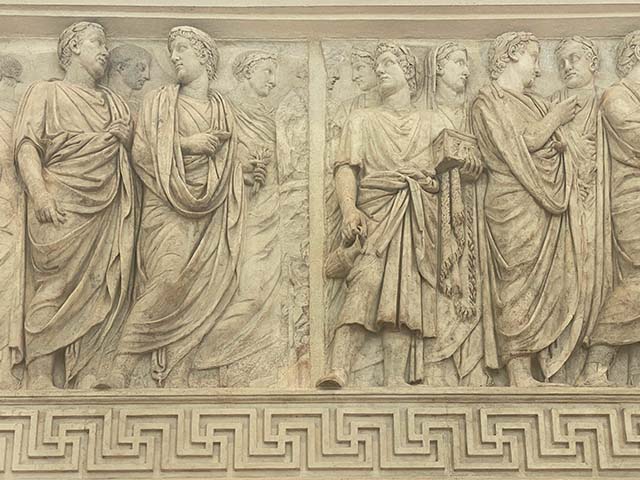 The level of artistic detail on in the processional scenes is one of the reasons the Altar of Augustan Peace continues to captivate visitors.
The level of artistic detail on in the processional scenes is one of the reasons the Altar of Augustan Peace continues to captivate visitors.The East Wall
Moving to the 'back' of the Ara Pacis Augustae, you will find in the top left panel possibly the best known relief from the monument.
This frieze shows a Roman goddess, who exactly it is is subject to debate still however.
Theories propose that it could be Tellus (mother earth) or Venus, the divine mother of Aeneas and from whom emperor Augustus claimed he was descendant.
The goddess is at the center of a familial scene, where she holds two young boys, possibly Augustus's heirs.
She is then flanked by two other women who are believed to represent Augustus' daughter Julia and his wife Livia.
On the opposite, right hand top panel you will see a largely-incomplete panel that displayed the goddess Roma.
This was ascertained during the early 20th century when the two small fragments now here were discovered.
The first featured part of a shield, the second elements of a seated female figure.
Only six years later was it recognized that these belonged to the same relief, and therefore based on other known examples, the overall figure was determined to be the goddess Roma.
The South Wall
Continuing clockwise around the Altar of Augustan Peace you will return to the processional scene that started on the north side.
At approximately one third along this scene (moving left to right), Augustus himself is visible.
Unfortunately his figure is incomplete, but instantly recognisable where he is wearing a laurel wreath and his surrounded by his 'lictor' bodyguards.
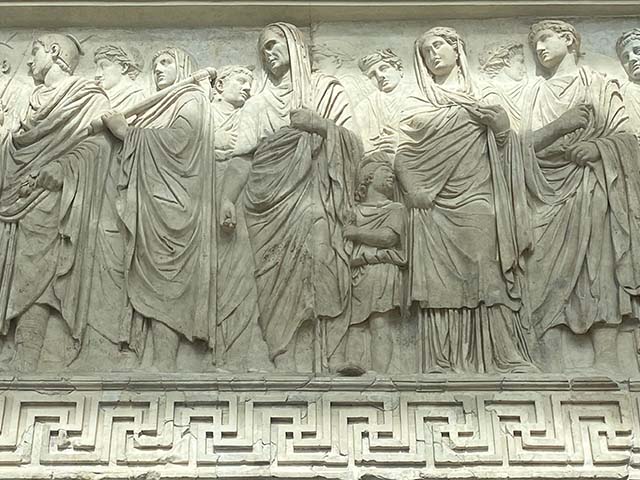 Agrippa, Augustus's most trusted friend and equivalent of Chief of Staff can seen here in the center of the photo leading the imperial household.
Agrippa, Augustus's most trusted friend and equivalent of Chief of Staff can seen here in the center of the photo leading the imperial household.Moving further left and beyond Augustus, you can see senior figures from the Roman state religion; priests and augurs.
The final section of this scene is dominated by members of the imperial household including Marcus Agrippa, August's right-hand man, recognized by his hooded head and Augustus-facing glance.
Ready to plan your trip?
Book your train
Planning to travel between cities in Italy and other parts of Europe?
Use Trainline to see all the different options available across the different rail companies.
Find your hotel
Find your perfect place to stay in Rome.
Use Booking.com to choose between hotels, guesthouses, and self-catering apartments in neighborhoods throughout the Eternal City.
Buy your TurboPass
Purchase the convenient Turbopass and visit all of Rome's top attractions including the Colosseum, Pantheon, and Vatican.
With one handy pass, it's all included.
Where to eat and drink near the Ara Pacis
If you are looking for a unique and secluded spot where you can take a break, and enjoy a unique view of the Ara Pacis museum and Mausoleum of Augustus, head to the terrace of the Bulgari Hotel at Piazza Augusto Imperatore.
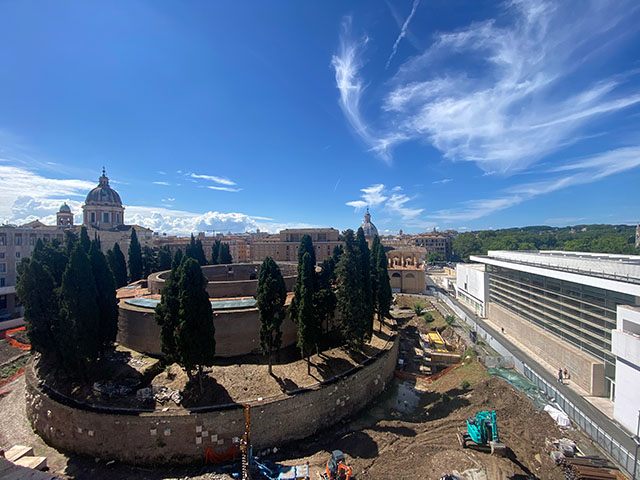 Head to the terrace bar at the nearby Bulgari Hotel for this view with the Ara Pacis Museum on the right, and the Mausoleum of Augustus on the left.
Head to the terrace bar at the nearby Bulgari Hotel for this view with the Ara Pacis Museum on the right, and the Mausoleum of Augustus on the left.The Ara Pacis is located not far from Piazza del Popolo where you will find a number of great spots to eat and drink.
Here are two of my favorites:
- Rosati - Here was where Federico Fellini, the famous Italian director would sit and scout for extras to be in his films. When someone passed by that fit his requirements, he would shout out and ask them to join him for a coffee! Soak up his heritage with a hot drink or aperitivo.
- Dal Bolognese Roma - Experience traditional Roman dining and cuisine in this institution of a restaurant, right next door to Rosati and with incredible views of Piazza del Popolo.
Romewise's Top Travel Resources
Ready to book your trip to Rome? Take a look at these helpful links to companies we use and trust:
- Keep your travel spending simple with the Wise card, which removes all the worry about exchange rates and high transaction fees all over the world
- Search for and book your perfect accommodation
- Our complete guide to what to pack for Rome
- The number one travel accessory, a multi-point travel adapter and voltage converter
- Browse a huge range of tours in Rome and beyond
- Experience unique tours and special access to Rome's most popular sights
- Protect yourself with comprehensive travel insurance
Within this post there are some affiliate links for products and services. For more details about our affiliate policy click here.
Get your 100% free Rome trip planner now!
Simply sign-up today for our free newsletter and get the Romewise Quick Start guide to Rome:
We are committed to respecting your data. Click for our Privacy Policy.
Comments? Questions? Suggestions?
Please come over to the private Romewise Facebook group and join in the conversation.
You will often find me there, happy to answer your questions / comments!
You will also meet other Rome lovers and experts, too.
What are you waiting for?
- Romewise Home Page
- What to Do in Rome
- Ara Pacis

